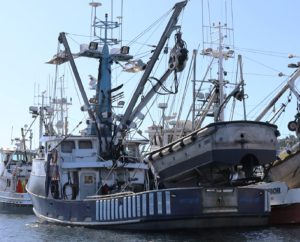What Caused the Sinking of the F/V Hotspur?
 The National Transportation Safety Board (NTSB) has completed an inquiry into the 2022 sinking of the F/V HOTSPUR near Prince of Wales Island. The report concludes that an unnoticed leak in an unoccupied area likely caused the vessel to lose stability, capsize, and sink near Nunez Rocks. Bilge alarms failed to sound or alert crew members that there was flooding below deck, which led to the capsizing of the 53-foot purse seiner.
The National Transportation Safety Board (NTSB) has completed an inquiry into the 2022 sinking of the F/V HOTSPUR near Prince of Wales Island. The report concludes that an unnoticed leak in an unoccupied area likely caused the vessel to lose stability, capsize, and sink near Nunez Rocks. Bilge alarms failed to sound or alert crew members that there was flooding below deck, which led to the capsizing of the 53-foot purse seiner.
On August 2, 2022, at about 7:35 PM, the captain and senior deckhand saw that the F/V HOTSPUR was listing to the port side while crossing the Clarence Strait. The captain went below to inspect the bilges and the engine room. He reported that everything appeared normal. To correct the listing of the vessel, the captain initiated a fuel transfer from a port-side tank to a starboard day tank. Despite his efforts, the listing persisted, and the senior deckhand noticed water spilling onto the rear deck from the port quarter.
The captain directed the senior deckhand to notify the other crewmembers to ready the life raft for abandoning ship. The captain transmitted a distress announcement via VHF radio. Nearby F/V LADY KODIAK and THE CODFATHER II heeded the call and altered their course to provide assistance.
The vessel listed further towards the port side as the crew deployed the life raft. Safely rowing away from the sinking vessel, the captain and his crew watched as it rolled and sank within approximately 20 minutes. The F/V HOTSPUR was deemed a complete loss, valued at an estimated $1.2 million. The vessel sank with about 1,100 gallons of fuel onboard. No salvage efforts were attempted.
Following the accident, the captain informed the NTSB that he could not recall the most recent testing of the bilge alarms for the lazarette and void spaces. According to records, the alarms were last evaluated in 2015 during U.S. Coast Guard testing, which confirmed they were in good condition. NTSB investigators speculated that these bilge alarms might have been non-functional during the voyage of the accident.
The NTSB also considered that the deck load of nets and gear might have surpassed the safety margin for stability. However, because the vessel lacked a stability booklet, such calculations are not possible. At less than 79 feet, the F/V HOTSPUR, constructed in 1988 as a purse seiner, falls outside the scope of stability regulations due to the vessel’s size and age; it was not subject to U.S. Coast Guard commercial fishing vessel stability requirements.
“Automatic high-water bilge alarms are intended to provide crews with an early warning of vessel flooding,” the report concluded. “In inaccessible spaces, or small spaces with limited means or ability to inspect underway, bilge level-monitoring alarms are often the sole means to alert operators of space flooding. Operators should periodically test bilge high-water alarms and follow best marine practices and manufacturer recommendations for inspection and maintenance.”
“The captain and crewmembers said they were not aware of any damage to the vessel along the transit,” according to the report. “However, the hull plating in the engine room had corrosion and wastage that required repairs 3 weeks before the voyage. Without evidence that the vessel was damaged or that flooding originated from another source, it is possible that the flooding was caused by deterioration of the hull plating in another area, which went undetected. “
The agency advises all operators to assess their bilge alarms regularly, since the devices provide the only available early warning system for void space flooding. Readers may find the entire NTSB Marititme Investigation Report at https://www.ntsb.gov/investigations/AccidentReports/Reports/MIR2403.pdf
 Maritime Injury Law Blog
Maritime Injury Law Blog

